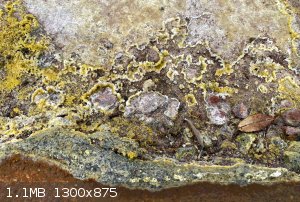SnailsAttack
Hazard to Others
  
Posts: 163
Registered: 7-2-2022
Location: The bottom of Lake Ontario
Member Is Offline
|
|
Stabilization of iron(II) by acids
I've read that acids are supposed to inhibit the air oxidation of iron(II) salts. Can someone explain how that's supposed to work?
For instance, iron(II) sulphate should oxidize in water by the following formula:
12FeSO₄ + 2H₂O + 3O₂ -> 4Fe₂(SO₄)₃ + 4FeO(OH)
Aside from redissolving the iron oxyhydroxide as iron(III) sulphate, why would the presence of sulphuric acid prevent this reaction from occurring?
|
|
|
Bedlasky
International Hazard
    
Posts: 1219
Registered: 15-4-2019
Location: Period 5, group 6
Member Is Offline
Mood: Volatile
|
|
I think because of electrode potentials.
Fe3+ + e- <--> Fe2+ E°= 0,771 V
Fe(OH)3 + e- <--> Fe(OH)2 + (OH)- E° = -0,56 V
Fe2+ solutions doesn't contain Fe(OH)2, but there is still some hydrolysis in which some basic salt is formed. Acid prevent hydrolysis.
Acid however doesn't stop oxidation of Fe2+. Acidic Fe2+ solutions are still sensitive to air.
|
|
|
SnailsAttack
Hazard to Others
  
Posts: 163
Registered: 7-2-2022
Location: The bottom of Lake Ontario
Member Is Offline
|
|
Quote: Originally posted by Bedlasky  | I think because of electrode potentials.
Fe3+ + e- <--> Fe2+ E°= 0,771 V
Fe(OH)3 + e- <--> Fe(OH)2 + (OH)- E° = -0,56 V
Fe2+ solutions doesn't contain Fe(OH)2, but there is still some hydrolysis in which some basic salt is formed. Acid prevent hydrolysis.
Acid however doesn't stop oxidation of Fe2+. Acidic Fe2+ solutions are still sensitive to air. |
So what
you're saying is that the acid just redissolves any hydrolyzed iron(II) salts? Like this:
FeSO₄(aq) + 2H₂O(l) <-> H₂SO₄(aq) + Fe(OH)₂(s)
Also, I found a relevant post about this: https://chemistry.stackexchange.com/questions/31243/what-is-...
[Edited on 2/25/2023 by SnailsAttack]
|
|
|
blogfast25
International Hazard
    
Posts: 10562
Registered: 3-2-2008
Location: Neverland
Member Is Offline
Mood: No Mood
|
|
Quote: Originally posted by SnailsAttack  | I've read that acids are supposed to inhibit the air oxidation of iron(II) salts. Can someone explain how that's supposed to work?
For instance, iron(II) sulphate should oxidize in water by the following formula:
12FeSO₄ + 2H₂O + 3O₂ -> 4Fe₂(SO₄)₃ + 4FeO(OH)
Aside from redissolving the iron oxyhydroxide as iron(III) sulphate, why would the presence of sulphuric acid prevent this reaction from occurring?
|
It's largely driven by the extreme insolubility of Fe(OH)3.nH2O: Ksp approx. 10-39 (!)
This causes the oxidation II to III to be favoured in neutral/alkaline conditions.
It also explains why Mohr's salt is much more stable than FeSO4, the latter which oxidises even in the solid (dry) form.
|
|
|
teodor
National Hazard
   
Posts: 872
Registered: 28-6-2019
Location: Heerenveen
Member Is Offline
|
|
Practically it is possible to store Fe(II) salts solutions for years without oxidation if you don't open the bottle too often and use something lile
ParaFilm.
I have Fe(SCN)2 test solution which was kept in a bottle for 1 year and it is still colorless. It turns pink on air very quickly, so you probably can
use this reagent to check how effective different ingibitors could work. And yes, the soluition contains HCl, and it doesn't inhibit oxidation much.
Update: for preparation of Fe(II) salt solution you can make it acidic and filter to the storage bottle through Zn powder. Addition of Fe(SCN)2 can
help to check the solution if not spoiled.
[Edited on 25-2-2023 by teodor]
|
|
|
SnailsAttack
Hazard to Others
  
Posts: 163
Registered: 7-2-2022
Location: The bottom of Lake Ontario
Member Is Offline
|
|
Quote: Originally posted by teodor  | Practically it is possible to store Fe(II) salts solutions for years without oxidation if you don't open the bottle too often and use something lile
ParaFilm.
I have Fe(SCN)2 test solution which was kept in a bottle for 1 year and it is still colorless. It turns pink on air very quickly, so you probably can
use this reagent to check how effective different ingibitors could work. And yes, the soluition contains HCl, and it doesn't inhibit oxidation much.
Update: for preparation of Fe(II) salt solution you can make it acidic and filter to the storage bottle through Zn powder. Addition of Fe(SCN)2 can
help to check the solution if not spoiled. |
I'm actually more interested in this behavior for its geochemical implications. This summer I observed that a sample of acid-rich volcanic fumarole
salts seem to contain iron(II) despite being exposed to air for months or even years.
Additionally, iron-oxidizing bacteria rely on the presence of iron(II).
|
|
|
j_sum1
Administrator
       
Posts: 6221
Registered: 4-10-2014
Location: Unmoved
Member Is Offline
Mood: Organised
|
|
Something like this?

|
|
|
Texium
Administrator
       
Posts: 4508
Registered: 11-1-2014
Location: Salt Lake City
Member Is Offline
Mood: PhD candidate!
|
|
In that scenario, I would guess it has a lot to do with the local atmosphere produced by the volcanic activity. Fumaroles are constantly belching out
gases that are not oxygen. The major gases released are either reducing agents, like H2S and SO2, or inert to redox, like
CO2 and water. It’s forming an area that is locally devoid of oxygen, making it a reducing atmosphere rather than the oxidizing
atmosphere we are accustomed to!
|
|
|
SnailsAttack
Hazard to Others
  
Posts: 163
Registered: 7-2-2022
Location: The bottom of Lake Ontario
Member Is Offline
|
|
Well, that looks a lot cooler than where I was but yeah I think it's geologically similar. The fumarole was underneath a street, leaking salts onto
the sidewalk (see attached pictures). Tasted extremely acidic. Still analyzing the sample I took.
Quote: Originally posted by Texium  | | In that scenario, I would guess it has a lot to do with the local atmosphere produced by the volcanic activity. Fumaroles are constantly belching out
gases that are not oxygen. The major gases released are either reducing agents, like H2S and SO2, or inert to redox, like
CO2 and water. It’s forming an area that is locally devoid of oxygen, making it a reducing atmosphere rather than the oxidizing
atmosphere we are accustomed to! |
Yeah, the majority of a fumarole system is highly reduced except where it breaches the surface. In my case though, the iron(II) salt I looked at was
already aboveground for... maybe a few weeks, at least, fully exposed to the air.
With the sample I took, the iron salts only began to precipitate after I neutralized the acid component with copper hydroxycarbonate.
 
|
|
|
SnailsAttack
Hazard to Others
  
Posts: 163
Registered: 7-2-2022
Location: The bottom of Lake Ontario
Member Is Offline
|
|
Maybe the oxidation of iron(II) salts proceeds through iron(II) hydroxide (more abundant in absence of acids due to hydrolysis) rather than the direct
oxidation of the iron(II) salt itself.
FeSO₄(aq) + 2H₂O(l) <-> Fe(OH)₂(aq) + H₂SO₄(aq)
4Fe(OH)₂(aq) + O₂(aq) -> 4FeO(OH)(s) + 2H₂O(l)
2FeO(OH)(s) + 3H₂SO₄(aq) -> Fe₂(SO₄)₃(aq) + 4H₂O(l)
Net reaction:
12FeSO₄(aq) + 2H₂O(l) + 3O₂(aq) -> 4Fe₂(SO₄)₃(aq) + 4FeO(OH)(s)
Iron(II) hydroxide does appear to oxidize almost immediately in air, so I think this would make sense.
Note that basic sulphate species (e.g. 'Fe(OH)SO₄') may also be present according to some sources.
[Edited on 2/27/2023 by SnailsAttack]
|
|
|